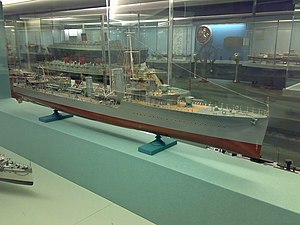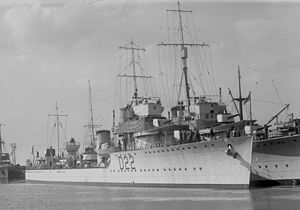V and W-class destroyer

HMS Veteran, an Admiralty modified W ship, a model at the Glasgow Museum of Transport
|
|
| Class overview | |
|---|---|
| Name: | V and W |
| Operators: | |
| Preceded by: | Parker class |
| Succeeded by: | Admiralty type destroyer leader |
| Subclasses: |
|
| Built: | 1916–24 |
| In service: | 1917–45 |
| Completed: | 67 |
| Cancelled: | 40 |
| General characteristics (see below) | |
| Type: | Destroyer |
| General characteristics (as built) | |
|---|---|
| Displacement: | 1,188 long tons (1,207 t) |
| Length: | 312 ft (95.1 m) (o/a) |
| Beam: | 29 ft 6 in (9.0 m) |
| Draught: | 11 ft 9 in (3.6 m) deep |
| Installed power: |
|
| Propulsion: | 2 × shafts, 2 × steam turbines |
| Speed: | 34 knots (63 km/h; 39 mph) |
| Range: | 3,500 nmi (6,500 km; 4,000 mi) at 15 knots (28 km/h; 17 mph) |
| Complement: | 134 |
| Armament: |
|
| General characteristics (as built, where different) | |
|---|---|
| Displacement: | 1,090 long tons (1,110 t) |
| Armament: |
|

HMAS Waterhen (D22)
|
|
| General characteristics (Admiralty W class) | |
|---|---|
| Displacement: | 1,100 tons |
| Draught: | 9 ft standard, 11 ft 3 in deep |
| Propulsion: | 3 Yarrow type Water-tube boilers (White-Forster type in Winchelsea, Winchester), Brown-Curtis steam turbines (Parsons in Waterhen, Wrestler, Wryneck), 2 shafts, 27,000 shp |
| Complement: | 110 |
| Armament: |
|
| Notes: | Other characteristics as per Admiralty V leader |
| General characteristics (Thornycroft V and W class) | |
|---|---|
| Displacement: | 1,120 tons standard |
| Beam: | 30 ft 6 in |
| Draught: | 10 ft 6 in |
| Propulsion: | 3 Yarrow type Water-tube boilers, Brown-Curtis steam turbines, 2 shafts, 30,000 shp |
| Complement: | 134 |
| Armament: |
|
| Notes: | Other characteristics as per Admiralty V leader |
| General characteristics (Thornycroft modified W class) | |
|---|---|
| Displacement: | 1,140 tons standard, 1,550 tons full |
| Beam: | 30 ft |
| Draught: | 10 ft 11 in |
| Propulsion: | 3 Thornycroft type Water-tube boilers, Brown-Curtis steam turbines, 2 shafts, 30,000 shp |
| Range: | 320-370 tons oil, 3,500 nmi at 15 kt, 900 nmi at 32 kt |
| Complement: | 134 |
| Armament: |
|
| Notes: | Other characteristics as per Admiralty V leader |
| General characteristics (Admiralty modified W class) | |
|---|---|
| Displacement: | 1,140 tons standard, 1,550 tons full |
| Beam: | 30 ft |
| Draught: | 10 ft 11 in |
| Propulsion: | 3 Yarrow type Water-tube boilers, Brown-Curtis steam turbines, 2 shafts, 30,000 shp |
| Speed: | 32 kt |
| Range: | 320-370 tons oil, 3,500 nmi at 15 kt, 900 nmi at 32 kt |
| Complement: | 134 |
| Notes: | Other characteristics as per Thornycroft modified W class |
The V and W class was an amalgam of six similar classes of destroyer built for the Royal Navy under the War Emergency Programme during the First World War and generally treated as one class. For their time they were among the most powerful and advanced ships of their type in the world, and set the trend for future British designs.
They arrived in time to see service in the First World War. During the interwar period these ships formed the backbone of the Royal Navy's destroyer flotillas until gradually replaced by new construction; by the mid-1930s most had been displaced to the reserve fleet. Most ships survived to make an extensive contribution to the Second World War effort, in the vital role of convoy escort, freeing up more modern ships for fleet action.
The V and W class were the ultimate evolution of British destroyer design in the First World War, embodying the improvements of their predecessors as well as new technological advances. Their lineage can be traced to the River or E class of 1902 that had introduced the classic raised forecastle into the Royal Navy. The Tribal class of 1905 introduced oil-firing and the resultant economies in size, consumption and crew. The Parker class leader of 1915 had introduced a raised shelter deck forwards, allowing two guns to be carried in the classic superfiring (i.e. one gun fires over the top of the one below and in front of it) "A" and "B" positions. The Yarrow Later M class, also of 1915, introduced a three-boiler, two-funnel layout allowing for a more compact hull and giving increased deckspace and the R class introduced geared turbines giving 30,000 shp on two shafts.
...
Wikipedia
